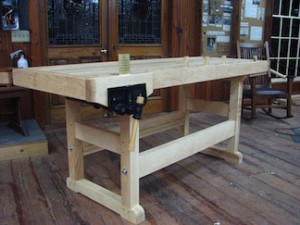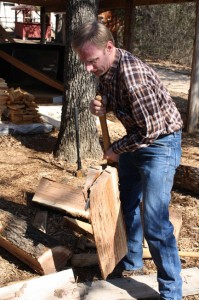This interview was originally published in the SustainLife Journal. See the original article here.
Q. Do you have any interesting stories from any of your classes that you could tell?
A. There are always interesting stories, but I think about one student in particular. He was in his 70’s. He had signed up for a foundational class, several years ago. He was a university professor, and although he had started getting interested in woodworking, he had no woodworking experience.
He had taken some classes at a local community college, but they were primarily focused on machines, and he said, “I just don’t want to do this. I just don’t want to work with machines. I don’t want the noise or the dust. I want to work with hand tools.”
So he took some other classes in different places, and then he found our school. He lived close enough to drive down, so he signed up for the six day foundational course. Like I said, he’d never really done much woodworking, but he really threw himself into it and did great. After that, he signed up for a two week class, building a Brazos rocking chair. This is a rocking chair that has a lot of hand-cut joinery, as well as shaping that’s done by hand.
While I was teaching that class, I was also working on building a viola (which is something I really like to do—violin-making), and he saw me working on it. Well, he’d been playing violin for fifteen or so years, and it’d never even crossed his mind to build a violin. He saw me working on it, and he asked, “Would you teach me how to build a violin?”
And I said, “Well, sure, I never really had a violin-making class, but I can teach you.”
So we started. He finished the rocking chair. It’s a two week class, and there’s a lot of work. We even help students to get through, at times. The rocking chair is a fairly advanced project, but he did well. He finished the rocking chair, and we scheduled a date for him to come to make the violin.
Now, violin-making is a fairly complex project, so I said, “It’ll probably take about 5 or 6 weeks”. We scheduled it in two week increments. He came for two weeks, then several months later he came back for another two weeks, and we did it that way. He had a great time. He built a violin, I built one right alongside him, and one of our students, who works in the shop, built one as well.
Would you teach me how to build a violin?’….The whole process has changed his life.
Well, it took seven weeks, by the time he varnished it and everything. He built a beautiful violin that he plays every day. He said building that violin was one of the highlights of his life, and he’s someone who has traveled all over the country. He’s done all kinds of things. But he has now thrown himself totally, 100% into violinmaking.
And now he’s gone to bow-making school. The whole process has changed his life. He can now actually create something with his hands, from wood, that makes beautiful music. It’s pretty inspiring, and it’s pretty exciting, too.
Q Are there any new classes that you plan to offer soon?
A We moved into online classes so that many more can take advantage of the experience.
Currently live:
- From a Log to a Spoon
- Sharpening Hand Tools
- Three Joints–Basics of Hand-Tool Joinery
Coming up over the next 4-6 weeks (already filmed)
- Dovetail Box
- Mortise & Tenon Wall Shelf
- Occasional Table
Next planned:
- End Table with Dovetailed Drawer
- Dovetailed Blanket Chest
- Advanced Dovetails
Folks see them and sign up here.
For years, we’ve had just a small number of project classes. People would complete the foundational course, and they’d always ask, “Well, what next? Now what do I do?” And oftentimes we’d say, “Well, we’ve got these few projects that you could do.” I felt we needed more project classes, so some years ago, I spent part of my time designing and developing new classes. Now we have several new project-oriented classes that people can take once they’ve completed the foundational class. These new classes will help them to both build their skills and to build an heirloom piece that they can take home with them.
I think probably the most requested on-campus class is the workbench class. Those classes have been very successful. But the only problem is that it is a two week class. I’m going to try to develop a workbench class that we can do in just six days. I’m working on that now so that we can have both options, a six day class or a two week class, depending on the complexity of the bench and the quality of the woods and the hardware and such. And we’ll do it online too.
Q How do you see woodworking fitting into a sustainable community and lifestyle?
A. There are so many things in a sustainable way of living that require woodworking, whether it be building a chicken coop, building a gate or building furniture for your home. Working by hand, you can do it both very effectively and fast. Say, for example, you needed a chest built for your home, or a chair, or a table.
When settlers came over from England in the 1600’s, they came over to an America with vast forests all around. But there was no way to cut the trees. How were they going to cut these oak trees? They may have had a way to cut them down with an axe, but then once they were felled, how were they going to rip them into boards? They didn’t have any huge saws. They didn’t have water-powered saw mills.
There was quite a bit of furniture in the 1600’s (17th century)—chests, tables, chairs—that were made with split wood. It’s very, very effective and very fast, and it’s simple to do using hand-tool methods. As one woodworker says, “Split oak is the best oak that money cannot buy.”
Because you take the wood, you crosscut it to length and split it. It splits perfectly with the grain, so you have perfectly straight boards that are very stable. And you can actually plane it. It hand planes beautifully when it’s green. Then after you plane it, you let it sit and dry for just a short time—it doesn’t have to be very long—just to get some of the surface moisture out, and then, using mortise and tenon joinery and draw bore construction, you build your piece. You can put together a chest with draw bore construction with no nails and no glue because there’s still some moisture in the wood, but as it dries, it all pulls together. There are pieces, many pieces, that were made during that time that are just as good today as the day they were made, still holding together. You can’t get more sustainable than that—cutting down a tree, splitting the wood, preparing the wood and making the furniture piece, all with hand tools. There’s really no need for big, huge mechanized saws or all that. Split rail fences were done the same way—you split fence rails to make your fences.
Q What has been the most enjoyable aspect of teaching at the woodworking school?
A Well, I get paid to do what I love to do! The most enjoyable aspect, I think, is meeting new people. Being able to meet all kinds of people from all walks of life, being able to impart new skills to them and see the excitement and enthusiasm in people that are just learning how to work with their hands, learning to create things—that, I think, is very enjoyable. Also, I enjoy learning new things, and I think teaching enables me to do that—to learn new things myself.
Q What do you most want your finished projects to express?
A The first thing that comes to me when you ask that is that I want my finished projects to express care and quality in craftsmanship. Those are the two things I most want my work to express—the quality of the piece and the craftsmanship, in every detail. And I want people, when they see my piece, to feel the harmony in it.





Comments are closed.